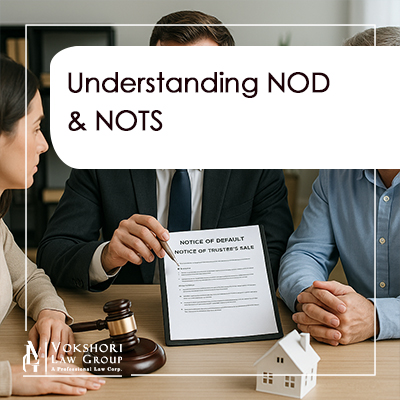
Recent statistics show that California foreclosure filings have increased by 41% in the past year. If your home is in foreclosure, you are far from alone.
Fortunately, California law provides important protections for homeowners to challenge wrongful foreclosures and potentially stop the process.
Below, we explain how the foreclosure process works in California—specifically the Notice of Default (NOD) and the Notice of Trustee’s Sale (NOTS)—and what you can do to protect your home.
Notice of Default (NOD)
The NOD is the first formal step in California’s non-judicial foreclosure process, governed by California Civil Code § 2924. When a borrower falls behind on their mortgage payments, the lender—or more commonly, the trustee—records the NOD at the county recorder’s office in the county where the property is located.
Key Requirements of the NOD:
• It must be recorded and mailed to the borrower, any junior lienholders, and others entitled to notice within 10 business days of recording.
• It must specify the nature of the default, the amount of payments in arrears (plus late fees and other charges), and provide contact information for the lender or servicer.
• It must include a declaration of compliance with the Homeowner Bill of Rights if the property is an owner-occupied residence, confirming that the lender contacted the borrower (or attempted contact) to explore foreclosure alternatives.
After the NOD is recorded, the borrower has at least 90 days to cure the default by paying the amount specified in the notice. This is called the “reinstatement period.” If the borrower pays the amount due, the foreclosure process stops.
Notice of Trustee’s Sale (NOTS)
If the borrower does not cure the default within the 90-day reinstatement period, the trustee may proceed by recording a NOTS. This step is also governed by California Civil Code § 2924f.
Key Requirements of the NOTS:
• It must be recorded, posted on the property, and mailed to the borrower and other interested parties at least 20 days before the scheduled auction date.
• It must specify the date, time, and location of the foreclosure sale, as well as the trustee’s contact information and a statement that the property will be sold at public auction to the highest bidder.
• It must include language explaining the borrower’s right to reinstate the loan up to five business days before the sale date (the “right of reinstatement” under Civil Code § 2924c).
The Auction Process
If the borrower does not reinstate or pay off the loan, the trustee’s sale proceeds at public auction. During the auction:
• Bidders must bring cash or cashier’s checks to pay the full amount of the winning bid.
• The auctioneer announces opening bids and accepts subsequent bids from registered participants.
• The highest bidder receives a trustee’s deed upon sale, extinguishing the borrower’s ownership interest (subject to certain statutory exceptions).
Preventing Foreclosure and Protecting Your Rights
A skilled California real estate litigation attorney can help you fight foreclosure by:
• Challenging improper notice or procedural defects in the NOD or NOTS.
• Identifying violations of the California Homeowner Bill of Rights, including dual tracking or failure to provide a single point of contact.
• Pursuing claims against the lender for unfair or deceptive practices.
• Seeking loan modifications or other loss mitigation alternatives.
Every foreclosure case is unique. Knowing your rights and securing the help of a lawyer to assert them is critical to protecting your home.
Fight the Foreclosure Process with Expert Help
Understanding California’s foreclosure process is step one toward protecting your property. At Vokshori Law Group, our attorneys work with property owners across California to challenge the legal authority of foreclosing banks.
Our years of experience and client-centered approach have led us to dozens of victories, and we’re excited to add you to our list. Contact us to schedule a free consultation and learn why we stand out.
Call us at (855) 855-2608 or visit www.VokLaw.com to learn more.






